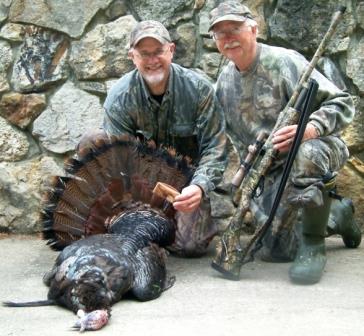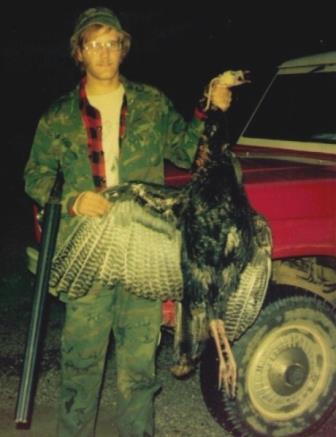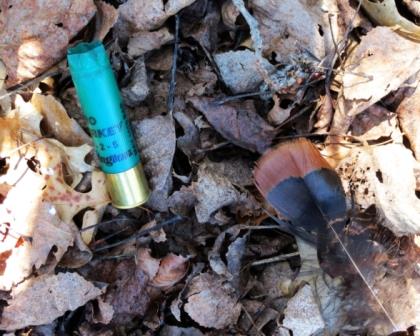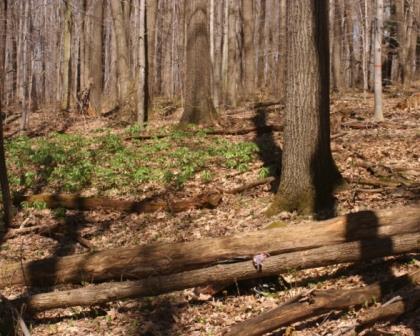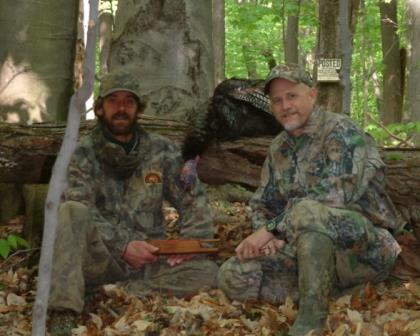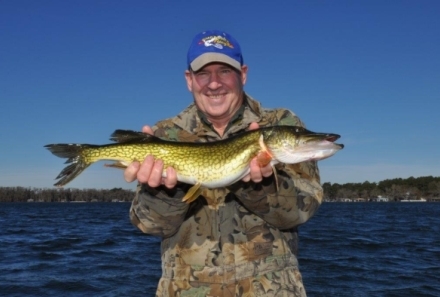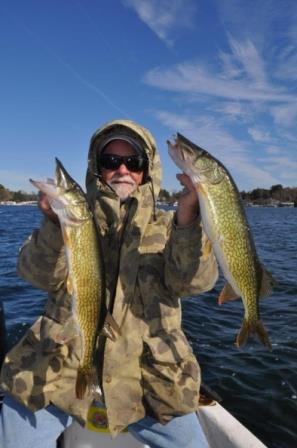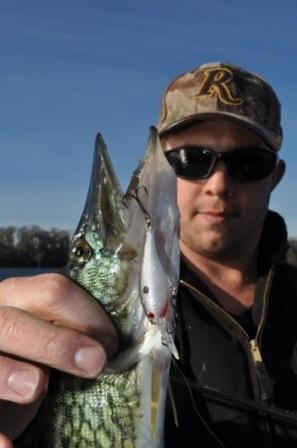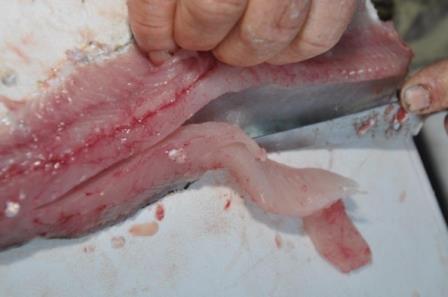By Mike Marsh
If you have the will to hunt challenging
late-season birds, one of these strategies will
help lead the way!

This set-up was irresistible to a mature gobbler with 1 1/4-inch spurs. It consists of a mounted hen, a plastic jake decoy and a gobbler decoy with a real fan mounted. The set-up was created to lure this dominant bird. The range was 10 yards. The weapon was a crossbow. (Photo: Mike Marsh)
When the weather gets hot and spring turkey season gets long in the tooth, the easy gobblers are gone. Hunters who still have a tag must switch attack plans, adapting to changing breeding habits and habitat use. Here are six ways to increase the odds of filling that tag.
1. Switch to a custom call
Mass-manufactured calls are based on traditional patterns and materials. Therefore, a lot of them sound pretty much the same. To give late-season gobblers something new to think about, I resist the temptation to employ custom calls during the early weeks and reserve them for the late season.
Ralph Jensen of The Master’s Touch (www.mastershoppe.com/calls.html) in Wilmington, North Carolina made my favorite custom call. The box is cherry and the lid is raised-grain chestnut that gives extremely raspy sounds. I also use Super Yelper (www.Superyelper.com) scratch boxes. Richard Shively uses different woods to make different sounds and tunes his calls to different pitches. Havalon writer and editor Steve Sorensen (www.EverydayHunter.com) also makes custom scratch boxes, and each of his calls produces a wide variety of pitches.
To call late-season turkeys I often use only my voice because it’s a natural sound. Master a hen’s yelps and cuts with your vocal chords and you can toss away the diaphragm. Another great late-season call few gobblers have heard is a homemade wing-bone.

The author used every trick in the book to fool this wary gobbler. One was hunting on a Sunday in North Carolina, when only archery gear is allowed. No other hunters were in the woods to ruin the set-up, and that may have helped bring this wary old gobbler into crossbow range. (Photo: Mike Marsh)
2. Raise the decoy bar
Gobblers learn to ignore poorly designed decoys, and they won’t often fool a late-season bird. However, incredibly life-like decoys are effective during later weeks, with those made by Dave Smith (www.davesmithdecoys.com) getting high marks.
I raise the bar with a mounted hen, and using a super-realistic jake decoy with her will help keep a strutting gobbler from hanging up when he sees her, which is a natural reaction. Her feathers moving in the wind and the old boy’s jake-jealousy often overpower his caution.
A last ditch trick is adding a gobbler decoy, whether it’s a stuffer or one with a real fan. Recently I used a Mojo Outdoors Scoot and Shoot (www.mojooutdoors.com) with a real fan to attract a dominant bird into 10 yards, and took him with a Horton Vision crossbow. I had hunted the old bird for days (perhaps years) without success.
Using a lifelike gobbler deke works best when you are certain you’re hunting the cock-of-the-walk. If he sees a real hen and a mounted gobbler or tail fan, he goes on the attack. A subordinate bird may display but hang up, or just run away.
3. Blind luck
Late in season, warier gobblers take their time coming to a call. A hunter must sit without moving as long as it may take because a gobbler can spot the slightest movement from a great distance. A blind keeps the hunter concealed and allows him to fidget without limit. If the bird arrives silently in what would be a bad shooting position for a hunter without a blind, the hunter remains undetected while he shoulders his shotgun.
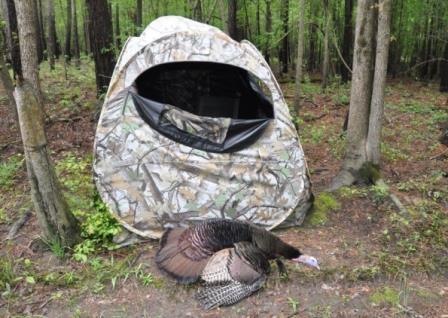
Mike Marsh took this gobbler by hunting from a blind. The bird came within 10 yards and was downed with an arrow from a crossbow. (Photo: Mike Marsh)
4. Hunt late in the day
By the end of the season, henned-up gobblers become rarities after 10 a.m. Peak hunting hours are between 10:30 and 12:30, but you might jumpstart a gobbling session anytime during the afternoon.
You may not hear as many gobblers when you hunt later in the day. However, any gobbler that sounds off is often more willing to come to a call than those you heard at sunrise because he probably doesn’t know where any hens are.
5. Follow the food
Many hunters don’t realize that when everything turns green, turkeys generally abandon food plots. Greenery in controlled burns and budding forests pull them away in favor of abundant natural foods, including grasses, seeds, buds, insects and other invertebrates.
I have taken turkeys that would not leave swamps as they filled their crops with dragonfly larvae, or wanted to stay in the timber where budding saplings were crawling with caterpillars. Examine the crop of a late-season gobbler and it will tell the tale.
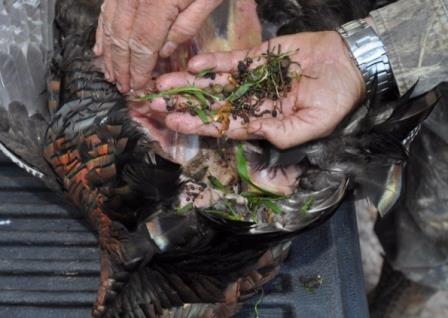
The crop of this gobbler held native seeds and vegetation and no evidence of man-made food plantings. (Photo: Steve Sorensen)
6. Share him with a friend
If a stubborn gobbler has you hearing gobbles in your sleep, share him. No two hunters call the same way. No two hunters take the same approach. A simple switch in calling techniques, decoys or set-up locations can turn the tide. Give your partner the lead role, allowing him to plan the hunt and call while providing him with just enough information to start the hunt. Follow along as an observer. Leave the calls you’ve been using at home, but be sure to bring your shotgun.
Late-season birds are a challenge, but if you have the will to hunt them, one of these six strategies will help lead the way.
About Mike Marsh:
 Mike Marsh’s articles, columns and photos have appeared in more than 100 magazines and newspapers. He lives in Wilmington, North Carolina and has written four books about the state’s hunting, fresh-water and salt-water fishing. His latest is “Fishing North Carolina.” To contact Mike, view his award-winning articles and photos or order his books, visit www.mikemarshoutdoors.com.
Mike Marsh’s articles, columns and photos have appeared in more than 100 magazines and newspapers. He lives in Wilmington, North Carolina and has written four books about the state’s hunting, fresh-water and salt-water fishing. His latest is “Fishing North Carolina.” To contact Mike, view his award-winning articles and photos or order his books, visit www.mikemarshoutdoors.com.
Want more turkey hunting tips and tricks?
Download our FREE eBook today!
Click here:
3,921 total views, no views today








